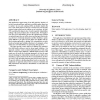Free Online Productivity Tools
i2Speak
i2Symbol
i2OCR
iTex2Img
iWeb2Print
iWeb2Shot
i2Type
iPdf2Split
iPdf2Merge
i2Bopomofo
i2Arabic
i2Style
i2Image
i2PDF
iLatex2Rtf
Sci2ools
126
Voted
ICSE
2008
IEEE-ACM
2008
IEEE-ACM
Static detection of cross-site scripting vulnerabilities
Web applications support many of our daily activities, but they often have security problems, and their accessibility makes them easy to exploit. In cross-site scripting (XSS), an attacker exploits the trust a web client (browser) has for a trusted server and executes injected script on the browser with the server's privileges. In 2006, XSS constituted the largest class of newly reported vulnerabilities making it the most prevalent class of attacks today. Web applications have XSS vulnerabilities because the validation they perform on untrusted input does not suffice to prevent that input from invoking a browser's JavaScript interpreter, and this validation is particularly difficult to get right if it must admit some HTML mark-up. Most existing approaches to finding XSS vulnerabilities are taintbased and assume input validation functions to be adequate, so they either miss real vulnerabilities or report many false positives. This paper presents a static analysis for finding ...
Related Content
| Added | 17 Nov 2009 |
| Updated | 17 Nov 2009 |
| Type | Conference |
| Year | 2008 |
| Where | ICSE |
| Authors | Gary Wassermann, Zhendong Su |
Comments (0)

